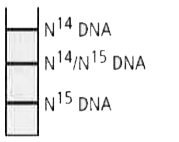E. coli cell grown on 15N medium are transferred to 14N medium and allowed to grow for two generations. DNA extracted from these cells is ultracentrifuged in a cesium chloride ensity gradient. What density distribution of DNA would you expect in this experiment?Solution in Tamil
One high and one low density band.
One intermediate density band.
One high and one intermediate density band.
One low and one intermediate density band.
The correct Answer is:d
Step by step video, text & image solution for E. coli cell grown on ""^(15)N medium are transferred to ""^(14)N medium and allowed to grow for two generations. DNA extracted from these cells is ultracentrifuged in a cesium chloride ensity gradient. What density distribution of DNA would you expect in this experiment? by Biology experts to help you in doubts & scoring excellent marks in Class 12 exams.
Updated on:21/07/2023Topper's Solved these Questions
- MOLECULAR GENETICSBOOK - PREMIERS PUBLISHERSCHAPTER - MOLECULAR GENETICSEXERCISE - OTHER IMPORTANT QUESTIONS & ANSWERS (Choose the correct answers: )
17 Videos
- MOLECULAR GENETICSBOOK - PREMIERS PUBLISHERSCHAPTER - MOLECULAR GENETICSEXERCISE - OTHER IMPORTANT QUESTIONS & ANSWERS (Answer the following )
29 Videos
- MICROBES IN HUMAN WELFARE BOOK - PREMIERS PUBLISHERSCHAPTER - MICROBES IN HUMAN WELFARE EXERCISE - OTHER IMPORTANT QUESTIONS & ANSWERS (ANSWER THE FOLLOWING)
19 Videos
- ORGANISMS AND POPULATION BOOK - PREMIERS PUBLISHERSCHAPTER - ORGANISMS AND POPULATION EXERCISE - OTHER IMPORTANT QUESTIONS & ANSWERS (IV. Answer the following)
4 Videos
Similar Questions
Gene is the functional unit of :
View SolutionDefine the following terms :
Gene
View SolutionGive an example of anaerobic microbe involved in bioremediation.
View SolutionGiven an account of adaptations of animals in response to temperature.
View SolutionEscherichia coli fully labelled with .^(15)N is allowed to grow in .^(14)N medium. The two strands of DNA molecule of the first generation of bacteria have :
View SolutionEscherichia coil fully labelled with .15N is allowed to grow in .14N medium. The two strands of DNA molecule of the first generation bacteria have
View SolutionA DNA molecule in E. coli is heavy and labelled with N^(15) . Iit is allowed to replicate in a medium containing N^(14) . After one generation of replication, the two daughter molecules will
View SolutionA heavy DNA (N^(15)N^(15)) of Egtcoli si allowed to replicated in N^(14) medium for 80 minutes. What would be the proportions of light (N^(14)-N^(14)) and hybrid densities of DNA (N^(14)-N^(15)) molecules?
View SolutionEscherichia coli, in which both the strands of DNA are labelled with .^(15)N , is transferred to .^(14)N medium and allowed to replicate for two generations. Find out the number of hybrid DNA molecues in the second generation
View SolutionIf hydrid DNA is allowed to replicate for one gernerative in medium containing N^(14) and for second generation in medium containing N^(15) then what is the proportion of light , heavy and hydrid DNA obtained respectively?
View SolutionE. coil with completely N^(15) DNA was allowed to replicate in N^(14) medium for two generations. Percentage of bacteria with heavy DNA will be
View SolutionE.coli cell grown on ""^(15)N medium are transferred to ""^(14)N medium and allowed to grow for two generations. DNA extracteed from these cells is ultracentrifuged in a cesium chloride density gradient. What density distrubution of DNA would you expect in this experiment?
View SolutionE. coli cell grown on ""^(15)N medium are transferred to ""^(14)N medium and allowed to grow for two generations. DNA extracted from these cells is ultracentrifuged in a cesium chloride ensity gradient. What density distribution of DNA would you expect in this experiment?
View SolutionDNA प्रतिकृतिकरण की अर्द्ध-संरक्षी प्रकृति को मीसेल्सन और स्थाल ने अपने बैक्टीरिया के साथ प्रयोगों में स्थापित किया। उन्होंने, बैक्टीरिया को N15−NH4CI माध्यम में उगाया, धोया और फिर N14 युक्त यौगिकों वाले ताजे माध्यम में इनक्यूबेट किया और उसे तीन पीढ़ियों तक बढ़ने दिया। विलगित DNA के CsCl घनत्व प्रवणता अपकेन्द्रण ने DNA प्रतिकृतिकरण की अर्द्ध-संरक्षी प्रकृति को स्थापित किया। नीचे दिया गया चित्रात्मक आरेख CsCIघनत्व प्रवणता में विभिन्न रूप से नामांकित DNA की स्थिति को दर्शाता है।

यदि DNA प्रतिकृतिकरण संरक्षी होता तो प्रतिरूप क्या होता?
View Solutionएश्चेरिचिया कोलाई की कोशिकाएँ उस माध्यम में कई पीढ़ियों के लिए विकसित की गई जिसमें एकमात्र उपलब्ध नाइटोजन भारी समस्थानिक 15N है। इसके पश्चात् उन्हें 14N वाले एकमात्र नाइट्रोजन रखने वाले माध्यम में स्थानान्तरित किया गया। उन कोशिकाओं के DNA अणुओं में 15N व 14N का कितना वितरण (Distribution) अपेक्षित रहेगा, जिन्हें 14N निहित रखने वाले माध्यम में एक पीढ़ी के लिए यह मानते हुए उगाया गया कि रेप्लीकेशन था-
(i) कन्जरवेटिव (ii) सेमीकन्जर्वेटिव (iii) डिसपर्सिव?
View SolutionA DNA molecule in E. coli is heavy and labelled with N15. Iit is allowed to replicate in a medium containing N14. After one generation of replication, the two daughter molecules will
View Solution
